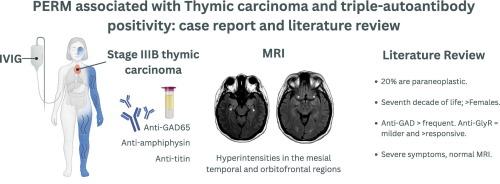PERM associated with thymic carcinoma with triple-autoantibody positivity: case report and literature review
IF 2.5
4区 医学
Q3 IMMUNOLOGY
引用次数: 0
Abstract
Introduction
Progressive encephalomyelitis with rigidity and myoclonus (PERM) represents a severe Stiff-person syndrome (SPS) variant with brainstem and autonomic involvement. Although PERM is occasionally paraneoplastic—typically associated with antibodies such as anti-GAD, anti-GlyR, and anti-amphiphysin—its association with thymic carcinoma has not been previously described.
Objective
To report a case of PERM associated with thymic carcinoma and triple autoantibody positivity in cerebrospinal fluid (CSF), and to review the literature on paraneoplastic and multiple-antibody PERM.
Methods
A literature review of paraneoplastic and multiple-antibody PERM cases was conducted in English. The case report follows CARE guidelines.
Case report
A 47-year-old Mexican-mestizo female patient was diagnosed with PERM secondary to stage IIIB thymic carcinoma. Brain MRI revealed hyperintensities in the mesial temporal and orbitofrontal regions. CSF analysis showed anti-GAD65, anti-amphiphysin, and anti-titin antibodies. Intravenous immunoglobulin therapy resulted in marked clinical improvement.
Discussion
The literature review demonstrated wide clinical and immunological heterogeneity. Most patients were female, typically presenting in later adulthood. Anti-GAD was the most frequent antibody, often coexisting with others in thymoma-associated cases. Presentations were consistently severe, often involving neuropsychiatric, autonomic, and brainstem symptoms, despite frequently unremarkable MRI findings. Coexisting antibodies in paraneoplastic cases were linked to more aggressive disease, while anti-GlyR positivity was associated with milder presentations and better treatment response. Early immunotherapy was generally beneficial.
Conclusion
This case highlights the need for timely oncologic and immunologic evaluation in atypical SPS presentations and underscores the therapeutic importance of early diagnosis and treatment.

PERM与胸腺癌合并三抗体阳性:病例报告及文献复习。
进行性脑脊髓炎伴强直和肌阵挛(PERM)是脑干和自主神经受累的一种严重的僵硬-人综合征(SPS)变体。尽管PERM偶有副肿瘤性,通常与抗gad、抗glyr和抗amphiphys2等抗体相关,但其与胸腺癌的关系尚未被报道。目的:报告1例胸腺癌合并脑脊液三抗体阳性的PERM病例,并复习有关副肿瘤及多抗体PERM的文献。方法:用英文对副肿瘤及多抗体PERM病例进行文献复习。病例报告遵循CARE指南。病例报告:一位47岁的墨西哥混血女性患者被诊断为继发于IIIB期胸腺癌的PERM。脑MRI显示颞骨内侧和眶额区有高信号。脑脊液分析显示抗gad65、抗amphiphysin和抗titin抗体。静脉注射免疫球蛋白治疗可显著改善临床症状。讨论:文献回顾显示了广泛的临床和免疫学异质性。大多数患者为女性,通常在成年后期出现。抗gad抗体是最常见的抗体,在胸腺瘤相关病例中常与其他抗体共存。表现一直很严重,通常包括神经精神、自主神经和脑干症状,尽管MRI表现通常不明显。副肿瘤病例中共存的抗体与更具侵袭性的疾病有关,而抗glyr阳性与较轻的症状和更好的治疗反应有关。早期免疫治疗通常是有益的。结论:本病例强调了在非典型SPS表现中及时进行肿瘤学和免疫学评估的必要性,并强调了早期诊断和治疗的重要性。
本文章由计算机程序翻译,如有差异,请以英文原文为准。
求助全文
约1分钟内获得全文
求助全文
来源期刊

Journal of neuroimmunology
医学-免疫学
CiteScore
6.10
自引率
3.00%
发文量
154
审稿时长
37 days
期刊介绍:
The Journal of Neuroimmunology affords a forum for the publication of works applying immunologic methodology to the furtherance of the neurological sciences. Studies on all branches of the neurosciences, particularly fundamental and applied neurobiology, neurology, neuropathology, neurochemistry, neurovirology, neuroendocrinology, neuromuscular research, neuropharmacology and psychology, which involve either immunologic methodology (e.g. immunocytochemistry) or fundamental immunology (e.g. antibody and lymphocyte assays), are considered for publication.
 求助内容:
求助内容: 应助结果提醒方式:
应助结果提醒方式:


